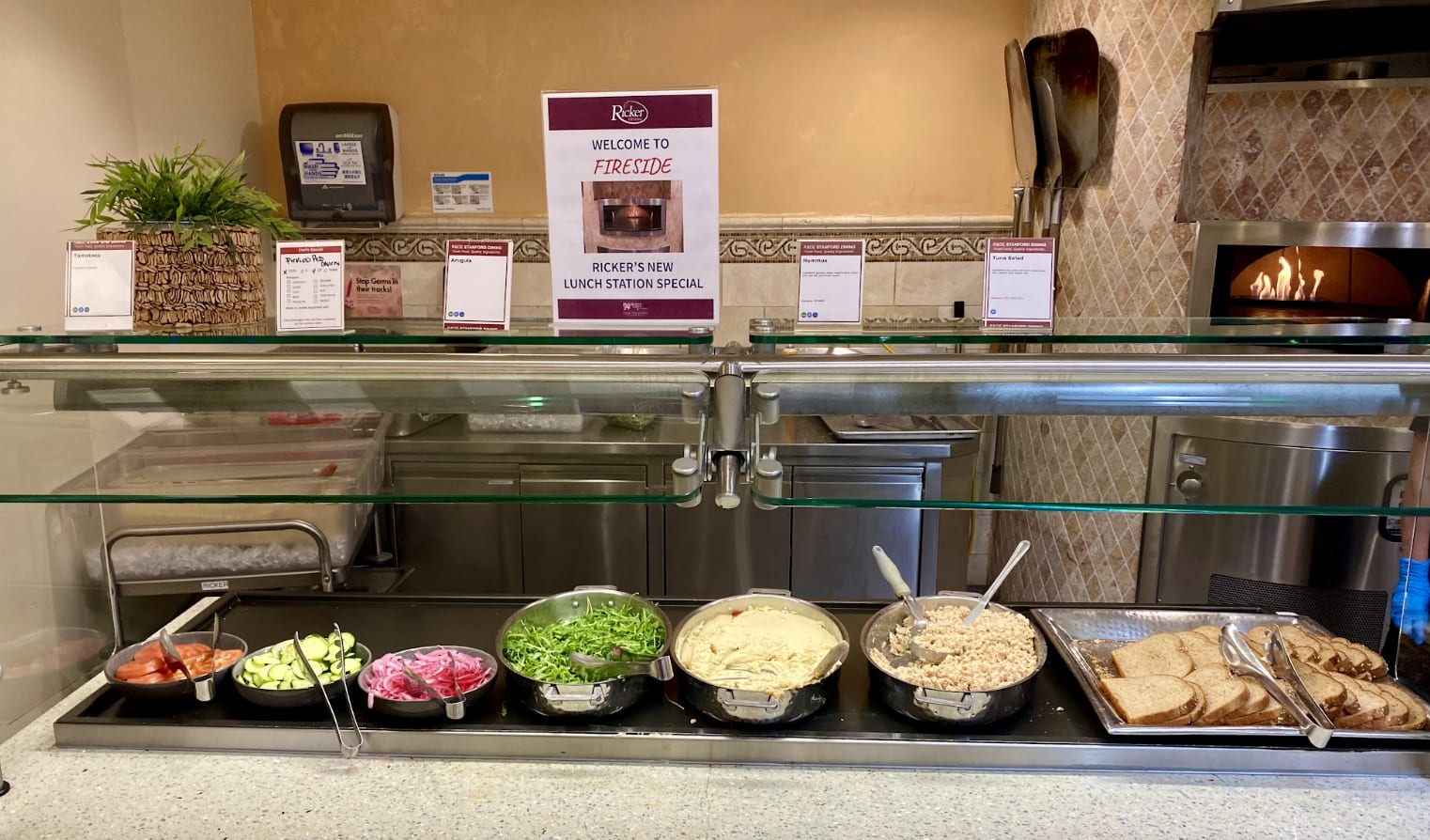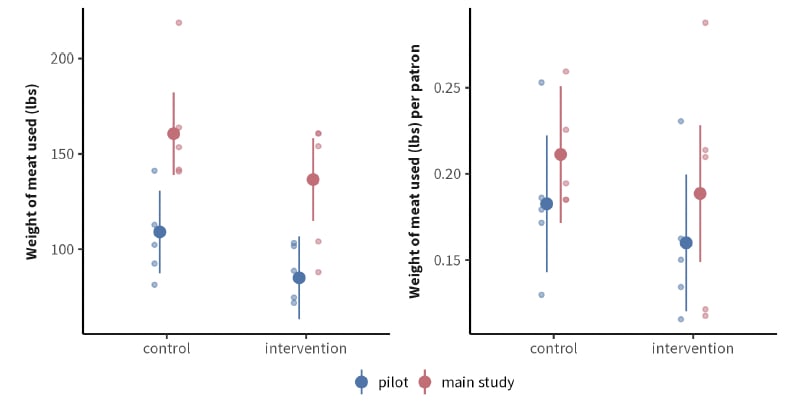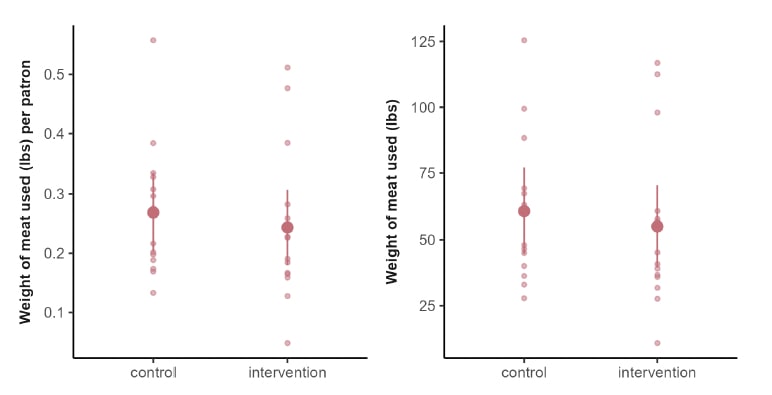This post summarizes a new preprint by the Stanford Humane and Sustainable Food Lab, led by PhD student Anaïs Voşki and former postdoc Mika Braginsky:
Voşki A, Braginsky M, Zhang A, Bertoldo J, Egan S, Levig LA, Ihrig MM, Mathur MB. Effect of a default portion-size reduction on meat consumption and diner satisfaction: Controlled experiments in Stanford University dining halls.
The preprint will ultimately be published in an academic journal, but has not yet undergone peer review. We welcome feedback!
Scientific abstract
Reducing animal-based food consumption, especially in Global North countries such as the United States, is an important factor in mitigating the climate and biodiversity crises and improving public health and animal welfare. Choice-architecture interventions or nudges that target the decision structure of consumers, especially within the food domain (e.g., reducing default portion sizes), have outperformed other intervention categories in most studies. Yet the evidence for nudging effectiveness is limited in large-scale, real-life settings, and little is known about effects on diner satisfaction and about backfiring effects that reduce or even reverse the desired behavior. Indeed, concern about the latter two has been a substantial barrier to scalability and wider adoption by the food service industry. In our single-blinded, quasi-experimental, and pre-registered studies in university dining halls, reducing the size of spoons used to serve meat by 25% resulted in ~24 lbs (18%) less meat consumed per day (Study 1, made-to-order burritos) but with a wide confidence interval that included the null. This intervention did not reduce diner satisfaction. Surprisingly, a more substantial 50% reduction in serving spoon size (Study 2, varying menu items) did not reduce consumption, triggered backfiring effects, and significantly decreased diner satisfaction. Internal meta-analysis indicated that on average, the two interventions reduced daily meat consumption by ~12 lbs with a small effect size (standardized mean difference= 0.24), but again with a wide confidence interval that included the null. Key differences in contextual nuances and factors may help explain these mixed results and underscore the importance and challenges of finding the ‘Goldilocks’ zone for successful portion size default nudges. Future research exploring different menu items and in different dining hall stations and food service industry models beyond staff-served is suggested to continue disentangling the nuances of these types of nudges in service of collective, societal-level sustainable diets.
Plain-language summary
Key design elements
- We tested the effectiveness of a default nudge: the meat in a staff-served, plated meal (which also included non-meat food items other) was a reduced portion size by default.
- To reduce portion sizes, we reduced the size of the spoon used to serve the meat, which simply means swapping the standard serving spoon for a smaller size.
- Diners could request additional meat.

- We implemented the intervention in college dining halls, a real-world food-service context that also resembles popular models such as workplace cafeterias, school canteens, and staff-served restaurant chains.

- We implemented the intervention on alternate weeks in the dining hall. The other weeks were control (regular spoon size).
- Primary outcome: Meat consumption as measured by weighing trays in the dining hall.
- Food service providers are unlikely to adopt interventions that reduce diner satisfaction and satiation, so we also assessed these using surveys.
- A risk of meat-reducing interventions is that they could cause compensatory effects (e.g., eating more meat at the next meal). We only implemented the intervention at lunch so we could see if meat consumption increased at dinner.
- Protocol and analysis plan were preregistered in detail.
Key findings
- Study 1: A 25% spoon-size reduction (from 4 oz to 3 oz) resulted in ~18% less meat consumed
- This study involved a single dish: made-to-order burritos, which always included one type of meat and other ingredients that the diner could customize, such as rice, beans, and vegetables
- The estimated effect of this intervention was 24 lbs less meat consumed on a daily basis
- There were no meaningful differences in diner satisfaction and fullness, and no compensatory effects at dinner

- Study 2: A more substantial 50% spoon-size reduction (from 4 oz to 2 oz) did not work
- This study involved varying menu items, such as Korean chicken and tuna melt sandwiches
- The intervention triggered backfiring effects, including increased meat consumption at dinner depending on the specific menu item and the intervention significantly increasing the odds of diners reporting that they ate meat as part of their meal
- Furthermore, diner satisfaction and diner fullness significantly decreased while diner hunger significantly increased
- No compensatory effects at dinner

Take-homes
- In order to implement this intervention, the meat has to be "scoopable" with a serving spoon, though other portion-size interventions could involve cutting smaller fillets, for example.
- The more subtle 25% spoon-size reduction appeared to be more effective than the more drastic and visually salient 50% reduction.
- The type of dish may also matter: if the meat is concealed (e.g., inside a burrito as in the first study), the reduced meat portion size is less obvious.
- The size of dish also matters: burritos are usually a larger meal and can thus still be filling despite the reduced meat portion size.
- Given that protein is highly satiating, future studies should explore compensating with plant-based protein to offset diner hunger in default portion size interventions.
Data availability
All code, data, and materials required to reproduce this research are publicly available. The preregistration is publicly available.
Funding
We thank Food Systems Research Fund for funding this work. The funders had no role in the design, conduct, or decision to publish this research.

